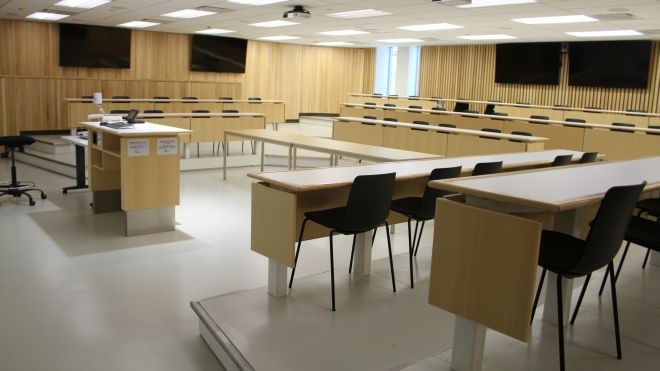Laurentian University was built at a time when colleges and universities looked institutional: dark, rudimentary and monolithic.
Over the past few years, the university's look has been undergoing a complete physical overhaul to bring its functionality and aesthetics to the 21st century.
These changes are not just to make it more appealing for students and faculty; it is to attract more people to use the post-secondary institution for everything from conferences to weddings.
“There have been a lot of changes over the last few years to make the university brighter, classrooms airier and more appealing,” said Julie Ceming, manager of conferences and events services at Laurentian University.
“There are many more coming, from the new entrance to the architecture and engineering buildings being built right now. We want to have spaces that attract people and have groups moving around interacting, sharing ideas.”
The once cramped, dark classrooms, sparse courtyards and long stretches of open ground with no services are being transformed to make it a brighter and livelier space for students and visitors.
One of the biggest changes to the university grounds was to add more common spaces for students to use in the classroom buildings away from the main buildings.
“There weren’t a lot of services for students on this part (the southeast side by the Northern Ontario School of Medicine and the School of Education) of campus,” she said.
“We looked around and chose this bunker-like old library in the (Alphonse Raymond Pavilion) French teacher's school to be the new location for a student common area.”
It was opened up to create an atrium, with floor-to-ceiling glass walls, a cafeteria, seating and a terrace with additional seating to create a bright, inviting place to sit.
The space was utilized for the first federal liberal cabinet meeting in Sudbury with Prime Minister Justin Trudeau.
The brighter, more open spaces have become the norm around the university, with many classrooms being renovated to create rooms that can be utilized for almost any use. Many are equipped with flat screens, audio-visual equipment and whiteboards, as well as furniture that can be removed or rearranged.
“Some of these rooms have screens and boards all around the room to accommodate the presentation styles of whoever is using these rooms,” Ceming said.
The university has a long history with Aboriginal students and programs geared towards First Nation cultures.
To give Aboriginal students a stronger presence at the school, the Indigenous Sharing and Learning Centre was placed at the front in what will be the new main entrance to make it more visible and add more meeting spaces that have cultural significance, such as the round room, where people can book meetings, as well as a ceremonial fire pit, medicine plant garden and open spaces.
“I've hosted events in this open area,” Ceming said. “It's a great place to have a relaxed meeting.”
Like a lot of colleges and universities, the student residences are made available for individuals and groups during summer months.
“They are there for groups coming here for events and even travellers passing through the city looking for a place to stay even overnight,” Ceming said.
The university added a third residence tower about four years ago, she said. When it was built, it had comfort in mind and included a lounge and cafeteria area on the ground floor.
The famous Great Hall, the main dining area of the university, is also available for rental for any occasion. The hall includes stations where people can choose from a wide menu, from vegetarian to different ethnic foods.
The university's grounds boast their own beach, swimming pool, gyms and even a “Turbo Tower” — a vertical obstacle course Ceming said is popular for retreats and teambuilding exercises.
“I had a group of 60-year-olds out there; we did a lot of ground work, but I overcame my fear of heights and climbed it,” she said. “I take my kids on that thing. It's a lot of fun and quite a workout.”
Other leisure includes the University Club, a private dining space usually reserved for faculty and staff lunches, but which can be rented to host gatherings. It includes a terrace, bar and ceiling-to-floor atrium glass walls.
The university has more meeting space conveniently located in the heart of the downtown at the McEwen School of Architecture. They boast several spaces that can be rented for events, including the atrium, an open area known as the “Crit Pit,” and a state-of the art lecture hall that can be combined with another room to create a larger space.
The atrium, Ceming said, is already popular, with several events being booked in it, from receptions to government announcements. They also have a boardroom and an atrium on the roof that can fit around 60 people.
“It is an innovative way to incorporate the old Canadian Pacific telecommunications building that was here and the cutting edge technology,” she said. “They recycled a lot of parts from the building, like the doors, and added them to the aesthetic.”
The outside also features a courtyard and moveable fire pit for events.
Since the school opened, Ceming said it has brightened the downtown overall, attracting not just students but people attending events in the building.
“It attracts people, business are responding, and there are more small boutiques opening in the downtown,” she said. “It has really added life to the area. Despite being next to train tracks, it really is peaceful.”




